[English] 日本語
 Yorodumi
Yorodumi- PDB-4oi7: RAGE recognizes nucleic acids and promotes inflammatory responses... -
+ Open data
Open data
- Basic information
Basic information
| Entry | Database: PDB / ID: 4oi7 | |||||||||
|---|---|---|---|---|---|---|---|---|---|---|
| Title | RAGE recognizes nucleic acids and promotes inflammatory responses to DNA | |||||||||
 Components Components |
| |||||||||
 Keywords Keywords | TRANSPORT PROTEIN / SIGNALING PROTEIN/DNA / protein-DNA complex / Ig fold / DNA binding / extracellular receptor / SIGNALING PROTEIN-DNA complex | |||||||||
| Function / homology |  Function and homology information Function and homology informationadvanced glycation end-product receptor activity / negative regulation of blood circulation / positive regulation of endothelin production / regulation of CD4-positive, alpha-beta T cell activation / glucose mediated signaling pathway / positive regulation of monocyte extravasation / regulation of T cell mediated cytotoxicity / positive regulation of DNA-templated DNA replication / negative regulation of long-term synaptic depression / positive regulation of dendritic cell differentiation ...advanced glycation end-product receptor activity / negative regulation of blood circulation / positive regulation of endothelin production / regulation of CD4-positive, alpha-beta T cell activation / glucose mediated signaling pathway / positive regulation of monocyte extravasation / regulation of T cell mediated cytotoxicity / positive regulation of DNA-templated DNA replication / negative regulation of long-term synaptic depression / positive regulation of dendritic cell differentiation / regulation of p38MAPK cascade / regulation of non-canonical NF-kappaB signal transduction / positive regulation of amyloid precursor protein catabolic process / transcytosis / induction of positive chemotaxis / positive regulation of heterotypic cell-cell adhesion / positive regulation of monocyte chemotactic protein-1 production / S100 protein binding / positive regulation of p38MAPK cascade / regulation of long-term synaptic potentiation / protein localization to membrane / regulation of spontaneous synaptic transmission / negative regulation of connective tissue replacement involved in inflammatory response wound healing / scavenger receptor activity / laminin receptor activity / negative regulation of interleukin-10 production / positive regulation of double-strand break repair / positive regulation of activated T cell proliferation / response to amyloid-beta / TRAF6 mediated NF-kB activation / Advanced glycosylation endproduct receptor signaling / negative regulation of long-term synaptic potentiation / phagocytosis / phagocytic cup / transport across blood-brain barrier / positive regulation of chemokine production / positive regulation of interleukin-12 production / astrocyte activation / positive regulation of interleukin-1 beta production / positive regulation of JNK cascade / microglial cell activation / positive regulation of non-canonical NF-kappaB signal transduction / positive regulation of NF-kappaB transcription factor activity / TAK1-dependent IKK and NF-kappa-B activation / regulation of synaptic plasticity / positive regulation of interleukin-6 production / response to wounding / fibrillar center / cellular response to amyloid-beta / neuron projection development / positive regulation of tumor necrosis factor production / cell junction / transmembrane signaling receptor activity / signaling receptor activity / amyloid-beta binding / regulation of inflammatory response / histone binding / molecular adaptor activity / learning or memory / early endosome / response to hypoxia / cell surface receptor signaling pathway / positive regulation of ERK1 and ERK2 cascade / postsynapse / apical plasma membrane / inflammatory response / protein-containing complex binding / cell surface / DNA binding / RNA binding / extracellular region / identical protein binding / nucleus / plasma membrane Similarity search - Function | |||||||||
| Biological species |  Homo sapiens (human) Homo sapiens (human) | |||||||||
| Method |  X-RAY DIFFRACTION / X-RAY DIFFRACTION /  SYNCHROTRON / SYNCHROTRON /  MOLECULAR REPLACEMENT / Resolution: 3.104 Å MOLECULAR REPLACEMENT / Resolution: 3.104 Å | |||||||||
 Authors Authors | Jin, T. / Jiang, J. / Xiao, T. | |||||||||
 Citation Citation |  Journal: J.Exp.Med. / Year: 2013 Journal: J.Exp.Med. / Year: 2013Title: RAGE is a nucleic acid receptor that promotes inflammatory responses to DNA. Authors: Sirois, C.M. / Jin, T. / Miller, A.L. / Bertheloot, D. / Nakamura, H. / Horvath, G.L. / Mian, A. / Jiang, J. / Schrum, J. / Bossaller, L. / Pelka, K. / Garbi, N. / Brewah, Y. / Tian, J. / ...Authors: Sirois, C.M. / Jin, T. / Miller, A.L. / Bertheloot, D. / Nakamura, H. / Horvath, G.L. / Mian, A. / Jiang, J. / Schrum, J. / Bossaller, L. / Pelka, K. / Garbi, N. / Brewah, Y. / Tian, J. / Chang, C. / Chowdhury, P.S. / Sims, G.P. / Kolbeck, R. / Coyle, A.J. / Humbles, A.A. / Xiao, T.S. / Latz, E. | |||||||||
| History |
|
- Structure visualization
Structure visualization
| Structure viewer | Molecule:  Molmil Molmil Jmol/JSmol Jmol/JSmol |
|---|
- Downloads & links
Downloads & links
- Download
Download
| PDBx/mmCIF format |  4oi7.cif.gz 4oi7.cif.gz | 204.5 KB | Display |  PDBx/mmCIF format PDBx/mmCIF format |
|---|---|---|---|---|
| PDB format |  pdb4oi7.ent.gz pdb4oi7.ent.gz | 161.4 KB | Display |  PDB format PDB format |
| PDBx/mmJSON format |  4oi7.json.gz 4oi7.json.gz | Tree view |  PDBx/mmJSON format PDBx/mmJSON format | |
| Others |  Other downloads Other downloads |
-Validation report
| Summary document |  4oi7_validation.pdf.gz 4oi7_validation.pdf.gz | 468.3 KB | Display |  wwPDB validaton report wwPDB validaton report |
|---|---|---|---|---|
| Full document |  4oi7_full_validation.pdf.gz 4oi7_full_validation.pdf.gz | 492.9 KB | Display | |
| Data in XML |  4oi7_validation.xml.gz 4oi7_validation.xml.gz | 21.8 KB | Display | |
| Data in CIF |  4oi7_validation.cif.gz 4oi7_validation.cif.gz | 29.4 KB | Display | |
| Arichive directory |  https://data.pdbj.org/pub/pdb/validation_reports/oi/4oi7 https://data.pdbj.org/pub/pdb/validation_reports/oi/4oi7 ftp://data.pdbj.org/pub/pdb/validation_reports/oi/4oi7 ftp://data.pdbj.org/pub/pdb/validation_reports/oi/4oi7 | HTTPS FTP |
-Related structure data
| Related structure data |  4oi8C  3o3uS C: citing same article ( S: Starting model for refinement |
|---|---|
| Similar structure data |
- Links
Links
- Assembly
Assembly
| Deposited unit | 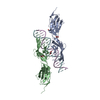
| ||||||||
|---|---|---|---|---|---|---|---|---|---|
| 1 |
| ||||||||
| Unit cell |
|
- Components
Components
| #1: Protein | Mass: 24195.580 Da / Num. of mol.: 2 / Fragment: UNP residues 23-237 Source method: isolated from a genetically manipulated source Source: (gene. exp.)  Homo sapiens (human) / Gene: AGER, RAGE / Production host: Homo sapiens (human) / Gene: AGER, RAGE / Production host:  #2: DNA chain | | Mass: 6761.380 Da / Num. of mol.: 1 / Source method: obtained synthetically #3: DNA chain | | Mass: 6743.352 Da / Num. of mol.: 1 / Source method: obtained synthetically #4: Chemical | ChemComp-EDO / #5: Water | ChemComp-HOH / | Has protein modification | Y | |
|---|
-Experimental details
-Experiment
| Experiment | Method:  X-RAY DIFFRACTION / Number of used crystals: 1 X-RAY DIFFRACTION / Number of used crystals: 1 |
|---|
- Sample preparation
Sample preparation
| Crystal | Density Matthews: 3.18 Å3/Da / Density % sol: 61.28 % |
|---|---|
| Crystal grow | Temperature: 298 K / Method: vapor diffusion, hanging drop / pH: 7.4 Details: 12% PEG6000, 0.1 M Tris-HCl, pH 7.4, VAPOR DIFFUSION, HANGING DROP, temperature 298K |
-Data collection
| Diffraction | Mean temperature: 298 K |
|---|---|
| Diffraction source | Source:  SYNCHROTRON / Site: SYNCHROTRON / Site:  APS APS  / Beamline: 23-ID-B / Wavelength: 1.03 Å / Beamline: 23-ID-B / Wavelength: 1.03 Å |
| Detector | Type: MARMOSAIC 300 mm CCD / Detector: CCD / Date: Nov 22, 2010 |
| Radiation | Monochromator: Double crystal cryo-cooled Si(111) / Protocol: SINGLE WAVELENGTH / Monochromatic (M) / Laue (L): M / Scattering type: x-ray |
| Radiation wavelength | Wavelength: 1.03 Å / Relative weight: 1 |
| Reflection | Resolution: 3.1→50 Å / Num. all: 13957 / Num. obs: 13817 / % possible obs: 99 % / Observed criterion σ(F): 0 / Observed criterion σ(I): 0 / Redundancy: 10 % / Rmerge(I) obs: 0.14 |
| Reflection shell | Resolution: 3.1→3.15 Å / Redundancy: 6 % / Rmerge(I) obs: 0.653 / Mean I/σ(I) obs: 1.97 / Num. unique all: 575 / % possible all: 85.6 |
- Processing
Processing
| Software |
| ||||||||||||||||||||||||||||||||||||||||||
|---|---|---|---|---|---|---|---|---|---|---|---|---|---|---|---|---|---|---|---|---|---|---|---|---|---|---|---|---|---|---|---|---|---|---|---|---|---|---|---|---|---|---|---|
| Refinement | Method to determine structure:  MOLECULAR REPLACEMENT MOLECULAR REPLACEMENTStarting model: PDB ENTRY 3O3U Resolution: 3.104→43.138 Å / σ(F): 1.38 / Phase error: 26.77 / Stereochemistry target values: TWIN_LSQ_F
| ||||||||||||||||||||||||||||||||||||||||||
| Solvent computation | Shrinkage radii: 0.9 Å / VDW probe radii: 1.11 Å / Solvent model: FLAT BULK SOLVENT MODEL | ||||||||||||||||||||||||||||||||||||||||||
| Refinement step | Cycle: LAST / Resolution: 3.104→43.138 Å
| ||||||||||||||||||||||||||||||||||||||||||
| Refine LS restraints |
| ||||||||||||||||||||||||||||||||||||||||||
| LS refinement shell |
| ||||||||||||||||||||||||||||||||||||||||||
| Refinement TLS params. | Method: refined / Origin x: 38.0286 Å / Origin y: -22.2532 Å / Origin z: -12.1861 Å
| ||||||||||||||||||||||||||||||||||||||||||
| Refinement TLS group |
|
 Movie
Movie Controller
Controller


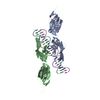
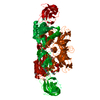

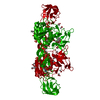
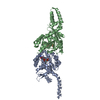
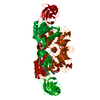
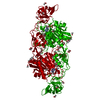
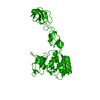
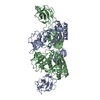
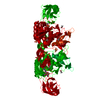
 PDBj
PDBj


















































